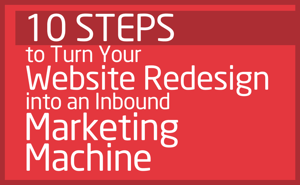 There comes a time in every organisation’s lifecycle when a website redesign is staring them in the face, and it’s an occurrence you simply cannot afford to ignore.
There comes a time in every organisation’s lifecycle when a website redesign is staring them in the face, and it’s an occurrence you simply cannot afford to ignore.
This could be for a multitude of reasons such as a rebrand, a strategy overhaul, or just that it looks increasingly dated.
Don’t sigh with despair when this issue arises, grab the bull by the horns and make your website work harder for you; turn it into an unstoppable inbound marketing machine.
Here’s how to in just ten steps:
1. Benchmarking your current metrics
This is one of those times where it’s ill advised to decide where you’re going until you assess where you’ve been. Metrics are relative, so you need to know what you’ll be comparing following your website redesign. Benchmarks to account for before you redesign your website for inbound marketing are website visitors and visits, bounce rate, SEO ranking and amount of sales generated, to name only a few. You can do this quite simply using Google Analytics, which we highly recommend.
2. Clarify your goals
Yes, of course you want an edgy looking site with beautiful graphics and a nice font – but what about the stuff that matters? The metrics mentioned in the previous step apply here too, so work out how you want them to improve, and how you’ll get there. Some other key numbers will be new leads, form submissions, and time spent on site, so prioritise the list in order of what’s most important for your business. Once that’s done you must ensure your team – from the top to the bottom – is aligned with these goals so that you can work collaboratively towards them.
3. Protect yourself; inventory your assets
After you take the decision to redesign your website for inbound marketing, it’s important to be aware of the risks associated with doing so. The biggest risk is potentially losing the most valuable parts of your website that you’ve pain-stakingly accumulated. Avoid this by making an inventory of those assets, including your most shared or viewed content, best performing keywords you rank for, and the number of inbound links to your pages.
4. Analyse the competition
As well as benchmarking your own performance pre-redesign, audit your competitors too! Visit their sites in a customer mindset and consider which parts you enjoy using and which you don’t. Of course we don’t recommend you copy competitors, but this is a highly useful exercise that takes you out of your own company’s frame of mind. A marketing automation tool will also help you to analyse competitor performance in great detail, giving you even more insight into their strengths and weaknesses.
5. Your unique value proposition
If you already have one of these, a website redesign is a fantastic opportunity to assess whether or not it still represents your business - and if you don’t, it’s time to create one. You must have a clear and compelling unique value proposition (UVP) that is reiterated across every page of your website in some subtle way. This doesn’t have to sound fancy; it just needs to describe how your business works to meet its customers’ challenges.
6. Build your design around personas
Yes, it’s those wonderful buyer personas again; the only way to truly identify who you are redesigning your website for, and what they might want out of it. It just takes three steps and you’re there: segment by demographics, identify those segments’ needs, and develop behaviour-based profiles for each segment. You can name them to make them feel a little more real, and then you’re ready to start creating content with their priorities in mind.
7. Optimise your site for search
In the process of redesigning your website, not only do you have to make visiting it a pleasant experience for users, but just as importantly make it possible for them to find it in the first place. To optimise your site you must: document your most search-valued pages, create a 301 redirect strategy, and make sure you do your keyword research. You may consider hiring an SEO expert to help with this and your ongoing strategy, but if you have the time and dedication, a marketing automation tool will offer comprehensive coverage on this front.
8. Convert with calls-to-action (CTA)
There’s no point in hoping your website visitors will instinctively know what next step to take on your site. Consider how often you find yourself on an external site, searching for a visual cue detailing where or how to take action. If that search takes your website visitors more than a few seconds your conversion rate is likely to be low – so make it easy for them! Give them clear, concise and relevant calls-to-action, and don’t leave them hovering in uncertainty – they’ll simply bounce if you do.
9. Plan for an ongoing content strategy
For once less is not more – in the context of content for an inbound marketing approach. The more pages your website has, the higher the ranking is likely to be; and the key is in keeping the content fresh. Do this through a regularly updated blog, PR pieces, and if you don’t have time to do all of this in house, outsource! Just make sure you are consistently adding high quality, relevant content to your site over time.
10. Don’t forget the extras!
Once the basics and essentials are in place, there are a few tweaks you can make and add-ons you can incorporate to make your site an invincible member of your inbound marketing army. Including a blog, landing pages (with clever calls-to-action), RSS subscription, share-ability and analytics could be all you need to take your website from mediocre to industry-leading.
Take the time to do all ten
What are you waiting for? Redesign your website for inbound marketing and watch your rankings rise. We’ve given you a quick whistle stop tour here, but for all the juicy details simply download our ebook in full, and start trouncing the competition.







Do you have any comments?